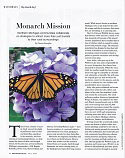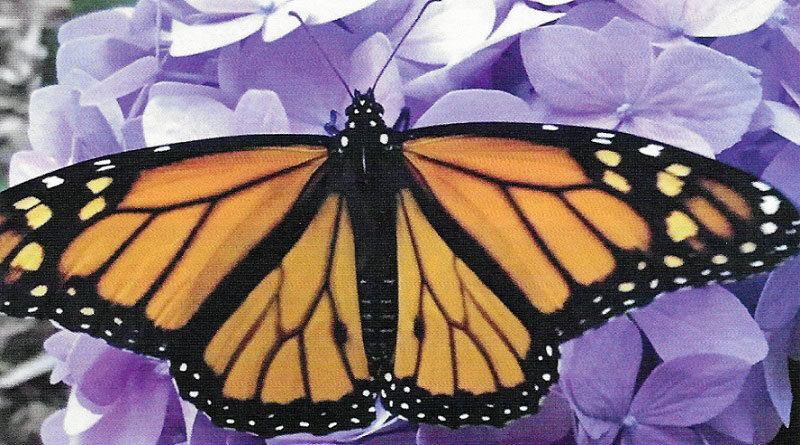Monarch Mission

Northern Michigan communities collaborate on strategies to attract more than just tourists to their rural surroundings
By Dianna Stampfler
There’s been a flutter of activity lately around the plight of pollinators like bees and butterflies, specifically the monarch, and how creating or maintaining habitats help ensure the future of these vital winged insects. In the past year, several northwest Michigan communities — Elk Rapids, Kalkaska, Boyne City, Beaver Island and Melrose Township (Walloon Lake) — have become members of a national initiative called Monarch Cities USA, pledging to protect and provide for these butterflies.
Monarchs are migratory butterflies, traveling back and forth between Mexico (where they winter) and northern United States or Canada. April through September are active viewing times, as the lepidopterans begin their long journey south. While several locales in northern Michigan serve as pitstops for these colorful orange-and-black creatures, the number is dwindling at an alarming rate.
The U.S. Fish and Wildlife Service notes that between 1990 and 2015, nearly 1 billion monarchs (85 percent of the insects’ onetime population) have vanished due to loss of habitat, which is caused by urban sprawl and pesticide usage. The monarch population has dropped to less than half of what it should be to avoid extinction, prompting conservationists to band together to generate awareness and develop a preservation plan.
Lauri Juday, who grew up in the Walloon Lake area and is responsible for its recent designation, has always been fascinated by monarchs. When she was a child, her mother taught her how to raise them from eggs to caterpillar to chrysalis and, ultimately, a butterfly. She still owns the original glass jar that served as the incubation center for this process, and she used it to educate her own children and grandchildren about monarchs.
Juday also grows milkweed and nectar plants from seeds that she collects and plants in her yard, her neighbors’ yards, and around the community. Her small pollinator garden, known as Springbrook Wings of Beauty, was added to the Monarch Watch in 2020 and is now among more than 42,000 registered waystations around the country. Throughout Michigan’s two peninsulas there are over 3,100 such waystations, including more than 40 in a four-county area of northern Michigan (Antrim, Charlevoix, Emmet, and Kalkaska).
Driving around the countryside, Juday points out dozens of places where waystation plantings could serve not only as feeding and nesting grounds for monarchs and other pollinators, but would also provide community beautification, enhance nature preserves and parks, reduce the need for mowing, and help combat erosion. She has guided the Walloon Lake Association and Conservancy (WLAC) in its efforts to add milkweed and other plants to various preserves through its recently launched Pollinator Protector Program. This summer, WLAC members and volunteers prepared and planted more than three collective acres at area preserves.
In nearby Boyne City, lifelong resident Skylar MacNaughton leads the monarch mission. With a desire to spend more quality time with his family and a need to refocus his life after battling a long opioid addiction (followed by the pandemic), MacNaughton formed the nonprofit Michigan Butterfly Habitats in 2022.
“The idea isn’t to just create pollinator habitats in northern Michigan but to get everyone locally involved, as well — getting the residents at retirement homes back in the dirt by helping us seed trays for our habitats, or helping them redo their own overgrown garden beds. It’s getting conservancies and conservationists alike all working together because we’re working for the same cause.”
MacNaughton and his family — his wife, Jessica, and children Bella and Jaxtyn — started with their own home butterfly garden in 2017, and have since spread out to the community with wild native propagation in Boyne City parks, including along the Boyne River on Spring Street. A long-term project involves covering the hillside with milkweed and native wildflowers at the 300-acre Avalanche Preserve Recreation Area, an effort that’s likely to take up to 10 years to complete.
Both Juday and MacNaughton, who’s also a Boyne City planning commissioner and a board member of the Charlevoix Conservation District, express the need to connect with key governmental agencies at the local and state level — from the Department of Natural Resources to the Department of Transportation — about the value of their initiatives.
“We hope to one day change the way Michigan road crews plant after new roads are built,” MacNaughton says. “Instead of just planting grasses, plant milkweed and wildflowers. If we can get all of Michigan on board for creating these native habitats, we can strengthen the monarch population and our own Michigan habitats.”
Not only do these projects benefit the winged pollinators, but they’re also therapeutic for those involved. “Being out in nature or helping Mother Nature in any way is therapy,” MacNaughton says. “And after the COVID years, we could all use some mental therapy.”
Winged Wonders
When Michigan communities joined Monarch City USA:
- Highland (July 2018)
- Elk Rapids (August 2022)
- Kalkaska (March 2023)
- Boyne City (May 2023)
- Melrose Township/Walloon Lake (May 2023)
- Beaver Island (July 2023)
- A handful of other northern Michigan communities are hoping to join the list in the coming months.
Did you know? There have been ongoing campaigns at the State Capitol to name the monarch butterfly Michigan’s official insect. Some have suggested mayflies or other butterflies. Michigan is one of only two states without an official insect. At least seven others have crowned the monarch butterfly as their state icon. — DS

